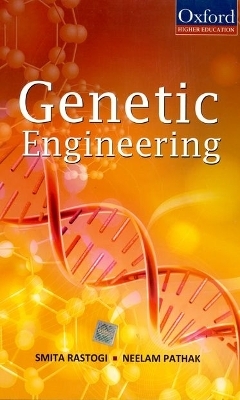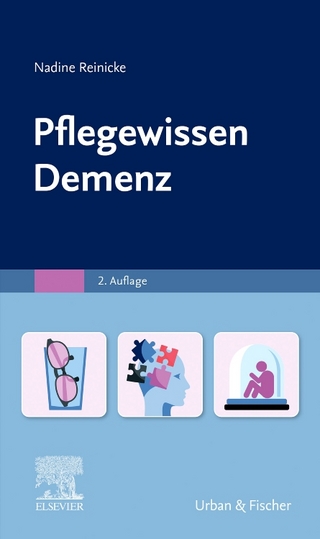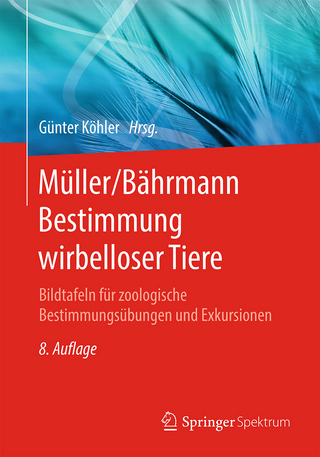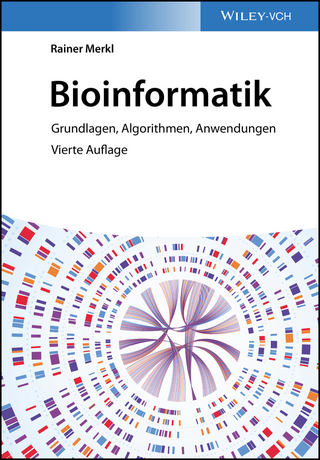
Genetic Engineering
OUP India (Verlag)
978-0-19-569657-8 (ISBN)
- Titel ist leider vergriffen;
keine Neuauflage - Artikel merken
Beginning with the basic concept of gene cloning, topics such as restriction endonucleases, chemical synthesis of oligonucleotides, cDNA synthesis, plasmids, and polymerase chain reaction have been discussed in detail in this book. The book also contains separate chapters on molecular markets and public concerns. All chapters begin with the chapter objectives and provide a exhausitive recap of the important concepts at the end of the chapter followed by review
questions and numerical exercises.
The language is extremely lucid and pertinent and interesting facts and anecdotes have also been included in each chapter which should surely hold the interest of readers.
Dr. Smita Ratogi and Dr. Neelam Pathak are faculty members in the department of Biotechnology, Integral University, Lucknow. Both teach 'Genetic Engineering' and 'Molecular Biology' to postgraduate and undergraduate students.
Preface ; Abbreviations ; 1. Basic concept of gene cloning ; Definition of genetic engineering ; Outline of the process ; 2. Enzymes used in genetic engineering ; Restriction endonuclease ; DNA polymerase: ; DNA Pol I, Klenow fragment ; T4 DNA polymerase (Filling in and Trimming back) ; Thermostable DNA polymerases ; Terminal deoxynucleotidyl transferase ; RNA Polymerase ; Reverse transcriptase ; Alkaline phosphatase ; Polynucleotide kinase ; DNA ligase: ; E. coli DNA ligase ; T4 DNA ligase ; Deoxyribonuclease ; Ribonuclease ; 3. Restriction endonucleases ; Definition ; Discovery ; Classification: Type I, II and III ; Nomenclature ; Recognition sites: ; Palindrome, Two-fold axis of symmetry ; Specificity and mode of action ; Cognate methylases ; Restriction enzymes in genetic engineering: ; Sticky end cutters (definition, examples and advantages) ; Blunt end cutters (definition, examples and advantages) ; Rare base cutters (definition, examples and advantages) ; Isoschizomers (definition, examples and advantages) ; Heterohypekomers (definition, examples and advantages) ; List of restriction enzymes (nomenclature; recognition; cleavage sites) ; Unit of restriction enzyme activity ; Restriction digestion: partial and complete digestion ; Star activity ; Restriction digestion vs mechanical shearing method of generation of DNA fragments ; Application of restriction enzymes in restriction mapping ; 4. Chemical synthesis of oligonucleotides ; Why and when opt for chemical synthesis? ; Methods of chemical synthesis (details of the process; efficiency; advantages/ disadvantages): ; Phosphodiester method ; Phosphotriester method ; Phosphoramidite method ; Photolithographic method ; 5. cDNA synthesis ; Isolation of RNA and purification of mRNA ; cDNA vs genomic DNA ; Role of various activities of reverse transcriptase ; Various methods for first and second strand DNA synthesis (use of oligo-dT primers, random primers in first strand synthesis; use of replacement method, asymmetrically-tailed plasmid, oligonucleotide primers, random primers in second strand synthesis) ; RT-PCR ; 6. Subfractionation of DNA fragments ; Conventional agarose gel electrophoresis (principle; use of LMP; elution from gel) ; Polyacrylamide gel electrophoresis (principle) ; Pulsed Field Gel Electrophoresis (PFGE) (principle; variants) ; Density gradient centrifugation ; Gel filtration chromatography ; 7. Polymerase Chain Reaction ; Why and when use PCR? ; Principle of PCR ; Variants of PCR: ; DD-RTPCR ; Degenerate PCR ; Asymmetric PCR ; Inverse PCR ; Anchored PCR ; Real time PCR ; Scorpion PCR ; RT-PCR ; Error prone PCR ; Applications of PCR [Isolation of gene; PCR product cloning (TA cloning, Topo cloning); PCR based mutagenesis; cDNA synthesis; Rapid Amplification of cDNA Ends (RACE); PCR based molecular markers] ; 8. Plasmids ; Biology of plasmids: ; Definition ; Why is plasmid not considered genome? ; Plasmid size range ; Plasmid shapes: covalently closed circular, linear plasmids ; Plasmid classification on basis of phenotypic traits: Cryptic plasmid, Fertility (F)/ Conjugative plasmid ; Resistance (R) plasmid (mode of action of resistance genes) Bacteriocinogenic plasmid (mode of action of toxins), Degradative plasmid (mode of action of degrading genes), Virulence plasmid ; Mobilizable plasmid ; Plasmid host range ; Relaxed and stringent control of plasmid copy number ; Genome map of Col E1 plasmid ; Plasmid as cloning vector (recombinant plasmids): ; Advantages of using plasmid vectors ; Examples of plasmids: pBR322 (vector map; strategy of construction), pUC (vector map; strategy of construction) ; 9. Lambda phages ; Biology of y phage: ; Genome map of y phage ; Functions of various gene products ; Lysogeny and lytic cycle ; Importance of cos sites ; y phage as cloning vector: ; Advantages of using phage lambda vector ; Insertional and replacement vectors (definition; advantage/ disadvantage; examples; vector maps of important vectors) ; Importance of some terms associated with cloning in y vector: ; Insert capacity and packaging constraint, Temperature sensitive repressor, hfl A mutant host Amber mutations in lytic genes, rec A- host, Spi phenotype ; 10. M13 phages ; Biology of M13 phage: ; Genome map of M13 phage ; Functions of various gene products ; Phage assembly ; Structural and functional differences from y phage ; M13 phage as cloning vector: ; M13 series of vectors (important examples, geneology, advantages, sister vectors, hosts used) ; 11. Other vectors ; Chimeric vectors: ; Cosmid (definition; advantages; single cos and dual cos cosmids; examples) ; Phagemid (definition, advantages, examples, hosts and helper phages used) ; Phasmid (definition, advantages, examples) ; Fosmid (definition, advantages, examples) ; Tumor inducing plasmid (pTi) from Agrobacterium: ; Introduction to Agrobacterium ; Application in plant transformation ; Genome map of pTi ; Functions of various gene products ; pTi based vectors: Binary and cointegrate vector system (definition; examples; strategy of construction; advantages / disadvantages) ; Viral vectors: ; Advantages of using viral system as cloning vector ; Plant viral vectors ; Animal viral vector ; Artificial chromosomes: ; Bacterial artificial chromosome (BAC) ; P1-derived artificial chromosome (PAC) ; Bacillus subtilis, Streptomyces, Pseudomonas based vectors (advantages of cloning in non - E. coli systems) ; Shuttle vector ; Expression vector (examples with vector maps; importance of tissue specific, wound inducible, strong, regulatable, T7 and T3 promoters, Details of CaMV 35S promoter) ; Fusion vector (Translational and transcriptional fusion vectors; advantages of fusion proteins) ; Specialist vector (for protein secretion, protein solubilization, purification tags, surface display, production of RNA probes) ; Advanced gene tagging/ trapping vectors (Gene trap vector, Plasmid rescue vector, Enhancer trap vector, Activation tagging) ; 12. Yeast cloning vectors ; Why is a yeast system required? ; Types of yeast vectors: ; 2 plasmid ; Yeast integrative plasmid (YIp) ; Yeast episomal plasmid (YEp) ; Yeast replicative plasmid (YRp) ; Yeast centromeric plasmid (YCp) ; Yeast linear replicative plasmid (Ylp) ; Yeast artificial chromosome (YAC) ; Other fungal systems ; 13. Joining of DNA fragments ; DNA ligase ; Homopolymer tailing (definition; advantages/ disadvantages) ; Linkers (definition; advantages/ disadvantages) ; Adaptors (definition; advantages) ; 14. DNA delivery methods ; Methods for DNA delivery to bacterial system: ; Conjugation ; Mobilization and Triparental mating ; Chemical induction ; Preparation of competent cells and transformation by heat-shock or freeze-thaw method ; In vitro packaging and natural infection ; Transduction ; Transfection ; Ultrasonication ; Virus/ phage mediated genetic transformation ; DNA delivery to prokaryotic non - E. coli systems ; DNA delivery to yeast and other fungal systems ; Microprojectile bombardment ; Electroporation ; Microinjection ; DNA delivery into plants/ animals ; Agrobacterium mediated genetic transformation and integration of exogenous DNA into plant genome ; Virus mediated genetic transformation ; Microprojectile bombardment ; Electroporation ; Microinjection ; Liposome packaging ; Protoplast fusion ; Other uncommon methods: use of silicon carbide whiskers, ultrasonication ; DNA integration into bacterial genome ; DNA delivery to prokaryotic non - E. coli systems ; DNA delivery to yeast and other fungal systems ; 15. Cloning strategies using different vector systems ; Library: ; Genomic library (construction; calculation for probability to clone the desired DNA fragment) ; cDNA library (construction; effect of mRNA abundance) ; Genomic library vs cDNA library (advantages/ disadvantages) ; PCR product cloning ; TA cloning ; Topo cloning ; RT-PCR (an alternative to cDNA cloning) ; Strategy for cloning in plasmid vector ; Strategy for cloning in y insertion vector ; Strategy for cloning in y replacement vector ; Strategy for cloning in single cos cosmid vector ; Strategy for cloning in dual cos cosmid vector ; Strategy for cloning in yeast artificial chromosome ; Use of linkers, adapters, homopolymer tailing in cloning ; 16. Selection/ Screening of recombinants/ transformants ; Preparation of probe DNA (radioactive and non-radioactive labeling by methods as nick translation; end filling; random primer methods) ; Overview of techniques for recombinant selection and screening ; Functional (genetic) complementation (blue-white screening; red-white screening; importance of lac Z' and sup 4) ; Nutritional complementation (auxotrophic mutants) ; Gain of function ; Colony hybridization ; Plaque hybridization ; Southern blotting and hybridization ; DNA and RNA dot blot ; Zoo blot ; Plus-Minus screening ; Northern blotting, Reverse Northern blotting ; Immunological screening ; Western blotting ; South-Western blotting ; North-Western blotting ; Hybrid arrest translation (HART) and Hybrid release translation ; (HAT) ; DNA chip ; 17. Other techniques for gene manipulation ; Mutagenesis and recombination ; Site directed mutagenesis ; Transposon mutagenesis ; Chemical mutagenesis ; Insertional mutagenesis ; PCR based mutagenesis ; Site-specific recombination ; Post Transcriptional Gene Silencing ; Antisense RNA technology ; RNA interference ; Cosuppression ; 18. Techniques used in Genomics and Proteomics ; Genomics: ; Rapid DNA and RNA sequencing techniques: Sanger method, Maxam and Gilbert procedure ; Automated DNA sequencing ; Pyrosequencing ; High throughput Sequencing: Shot gun cloning, Chromosome walking, Clone contig assembly, Annotation ; Microarray ; Proteomics: ; Protein sequencing: N and C terminal sequencing, Edman degradation, Dansyl chloride ; 2-D electrophoresis ; Multi-D liquid chromatography ; Mass spectrometry ; MALDI-TOF ; Yeast two-hybrid system ; DNase I foot printing ; Protein Microarray ; 19. Applications of genetic engineering ; Cloning in plant cells: ; Developing insect resistance, disease-resistance, herbicide resistant, salt and submergence stress tolerant plants ; Quality improvement ; Edible vaccines ; Applications in biodiversity conservation ; Cloning in mammalian cells: ; Therapeutic cloning ; Reproductive cloning ; Origins of organismal cloning in developmental biology-search on frogs ; Nuclear transfer procedures ; Cloning of sheep (Dolly) and other mammals ; Gene knockout technology ; Transgenics ; Gene therapy ; Stem cell therapy ; 20. Public concerns ; Safety guidelines of recombinant DNA research (Containment facilities and disposal of radioactive material; Protection from exposure of ultraviolet light, ethidium bromide etc.) ; Ethical issues and prospects for human cloning ; Health and environmental concerns related to genetically modified organisms (GMOs)
| Zusatzinfo | 300 b/w and 50 colour illustrations |
|---|---|
| Verlagsort | New Delhi |
| Sprache | englisch |
| Maße | 219 x 281 mm |
| Gewicht | 1416 g |
| Themenwelt | Informatik ► Weitere Themen ► Bioinformatik |
| Naturwissenschaften ► Biologie ► Genetik / Molekularbiologie | |
| Technik ► Umwelttechnik / Biotechnologie | |
| ISBN-10 | 0-19-569657-3 / 0195696573 |
| ISBN-13 | 978-0-19-569657-8 / 9780195696578 |
| Zustand | Neuware |
| Haben Sie eine Frage zum Produkt? |
aus dem Bereich


